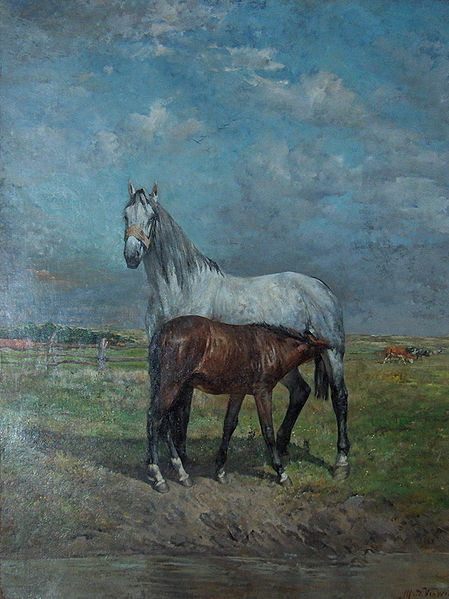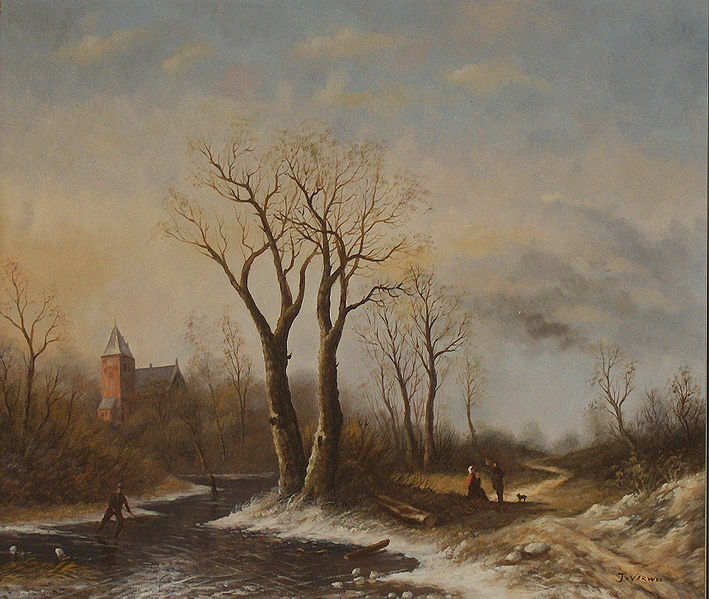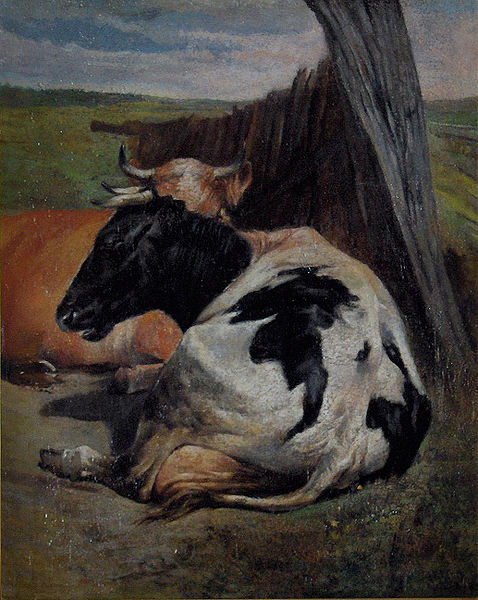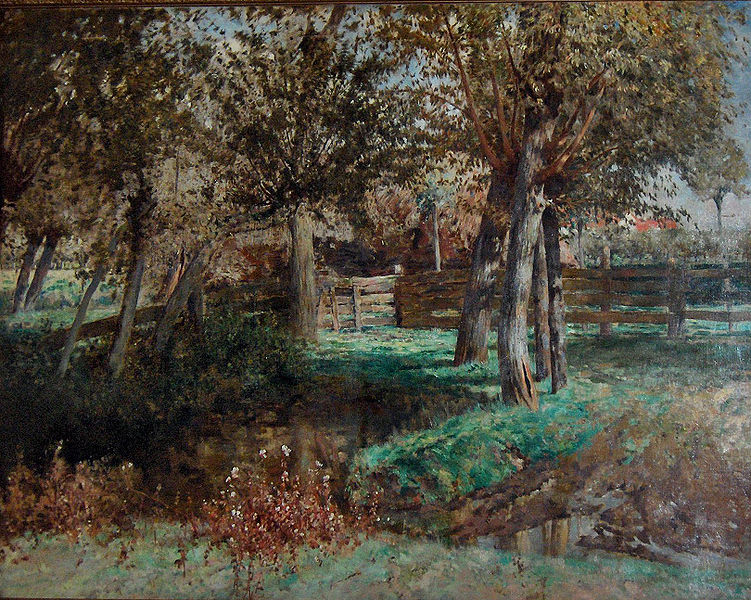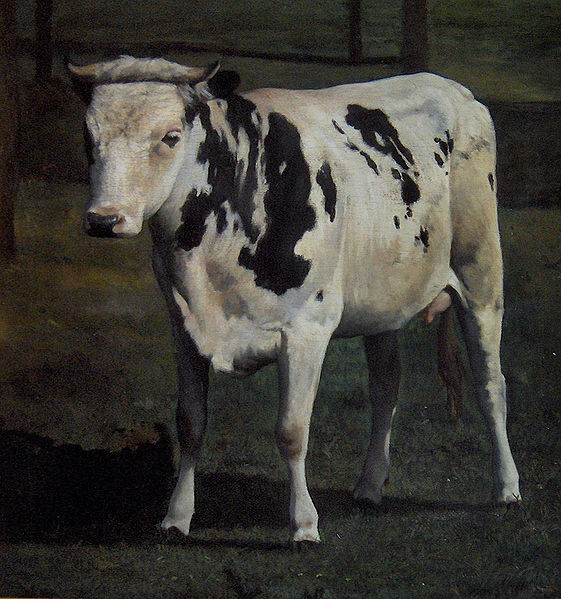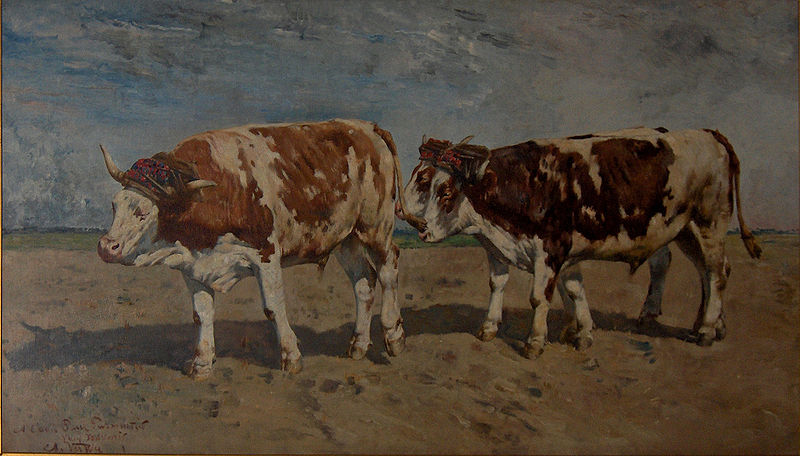<Back to Index>
- Mathematician Johannes (van Waveren) Hudde, 1628
- Painter Alfred Verwee Jacques, 1838
- 15th President of the United States James Buchanan, Jr., 1791
PAGE SPONSOR
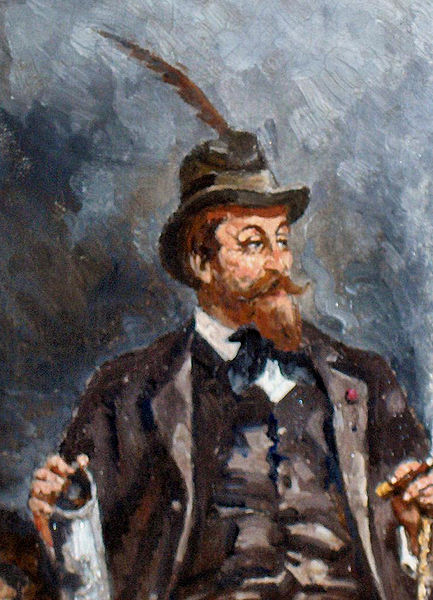
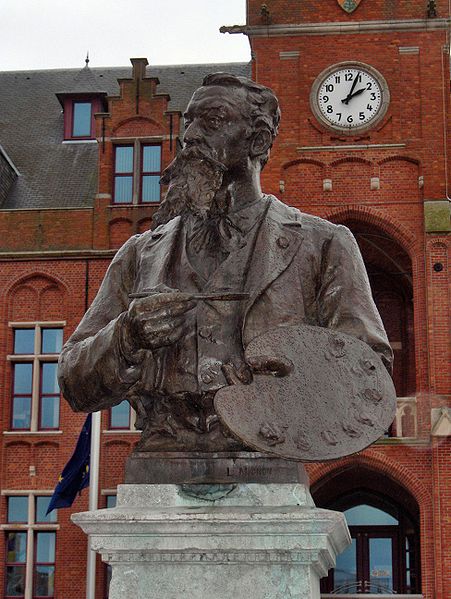
Alfred Verwee Jacques (Saint-Josse-ten-Node , 23 April 1838 - Schaarbeek , 15 September 1895) was a Belgian painter and etcher, known for his depictions of animals and landscapes.
His father was the Kortrijk painter Pierre-Louis Verwee (1807 - 1877), a romantic painter of winter landscapes, who had been a student of Eugene Verboeckhoven. His brother Louis-Charles Verwee , also a painter would be specializing in family scenes and portraits.
Alfred graduating Verwee became a surveyor, but was unable to continue studying engineering because of financial difficulties. Already in his youth he had began to paint as a hobby. He was supported by his father so he began to paint the same style of romantic landscapes and animals. At that time he was under the influence of Louis Robbe, Eugene Verboeckhoven and the Frenchman Constant Troyon, a supporter of the Barbizon School .
From 1853 he began
seriously thinking about following in the footsteps of his father and
become a painter. He was educated in
the private academy of the Brussels based genre and portrait painter Charles
François Deweirdt (1799 - 1855), who also came from Kortrijk, and
where Louis-Pierre Verwee worked. He led Alfred Verwee
in the pure academic-romantic tradition. Alfred Verwee was
enrolled at the Academy, but received only a few lessons there. He first
exhibited in 1857 at the Brussels Salon an animal painting "Cattle
at pasture". His breakthrough
would come in 1863 at the Brussels Salon with a similar painting "Attelage Flamand", for which he won a gold
medal. At the time of his
first successes Verwee had become a good realistic painter, but had not
yet the maturity of a great artist. He won another gold
medal at the Paris Salon of 1864 with his painting "The stringing of
the oxen" (purchased by the Museum of Kortrijk). The writer and art
critic Théophile
Gautier wrote
praises. Alfred Verwee met in
Paris the animal sculptor Antoine
Barye, who advised
him to further develop his career in Paris. During this period
he met Edouard
Manet and the
Barbizon School painters Théodore
Rousseau, Narcisse
Diaz
de la Peña . These contacts would
later lead to a remarkable change of style to realism in his works, reacting against the style of Eugene
Verboeckhoven and, also, Louis
Robbe and Joseph
Stevens . His stay in Paris
did not lead to the desired commercial success and in 1865 he went back
to Brussels. During that period
he became good friends in Brussels with the Hague marine painter Hendrik
Willem
Mesdag (who
also owned several works by Verwee). Through him came in
contact with Mesdag's cousin Lawrence
Alma-Tadema . He moved with his
family to London in the period 1867 - 1868. But he did not achieve commercial success there either and soon went home, as destitute as
before. He got married in
1868. In the same year he
undertook a journey through the Netherlands with his friend Louis
Dubois. Dordrecht with its fertile pastures
inspired him. Alfred Verwee was also
influenced by the Dutch landscape painter Willem
Roelofs, who then
lived in Brussels.
He became in 1868 a
founding member of the Brussels art circle " Société
Libre
des Beaux-Arts",
a group of young artists who rebelled against the academic and
romantic realists of previous generations. These young artists
wanted a freer, more realistic art style. In this environment
of burgeoning talent, Verwee developed further his style and technique. Verwee would
now spot in the wild subjects to
capture on canvas, a reaction against the academic style of his training. His realism was expressed between 1875 and 1880 by a grand vision of the Flemish
farmland, the polders and the banks of the Scheldt with cattle grazing
on fertile soil. He used lighter, more vibrant colors, put down with a
softer touch. This change of style
could be first seen in his painting "Landscape with cows" in 1868 (Museum
Mesdag , The
Hague). This new style
continued in his work "The Stallion", which yielded him a gold medal at
the Brussels Salon of 1869. He perfected this
style in the many works that followed: "Harvest in the north of
Flanders" (Salon 1872, Brussels), "A Span in Zeeland" (Salon, 1873),
"Meadow of poppies", "Banks of the Scheldt" (1873), "Horses in the region
of Ostend" (1878) and his masterpiece of the "Scheldt estuary" (1880). He also had a good
relationship with the artists from the School
of
Tervuren . He was a co-founder
in 1876 of the Brussels artists group "La
Chrysalide", which
existed until 1881. This circuit is
considered a precursor of the art "L'Essor" and later "Les
XX ". He was also friends
with Euphrosine
Beernaert , who had
come in contact with him through the animal painter Louis
Robbe. When he attempted to become
a member of Les XX, he was refused by James
Ensor and Willy
Finch. They took revenge as Alfred Verwee was one of the organizers of the Brussels
Salon, which had declined their work. Along with the
painters François
Musin, Louis
Dubois, Joseph
Van
Severen Donck and Amédée
Lynen, he was asked in 1878 by the architect Naert Laureys to participate
in the pictorial decoration of the new Kursaal of Ostend. He decorated a room
with paintings of different animals. This hall was later
named the Verwee hall. Around
1880, Alfred
Verwee fell under the spell of the Flemish coastal area of Knokke
Heist, its dunes and sea, but especially the underlying landscape. Gradually Knokke grew from only a hamlet into an artists' village
in the summer, attracting many leading artists from home and abroad. This lively artists'
colony was known as Knokke
Artist
Colony. The artists were on
friendly terms with each other and painted the picturesque spots in the
Knokke area and further to Zealand. Alfred Verwee
painted during this period in this area several mature works, using a
pre-impressionistic touch. He sought a
compromise between two specialties, painting animals and landscapes. His monumental cows,
pigs or horses, alone or in groups, are statically displayed in the
foreground with a photographic accuracy. This happened in his
studio. The landscape in the background was painted in the open air with
the Impressionist technique spots and using mostly clear to silvery
colors. This
combination did
not always achieve the desired result. Verwee always studied carefully
the pose for his subjects, which the anatomical accuracy of the animals
reflected. Thus he is regarded as
the purest animal painter in the Belgian art. Pol
de
Mont , the curator of the Museum of Fine Arts in Antwerp called him once: "Our
first anima winch". Some examples from
this period are "The beautiful Flanders" (1884) (KMSK Brussels) and
"Fighting between bulls" (KMSK Ghent). In 1885 Alfred
Verwee undertook a trip to Italy in the company of Baron Alphonse de
Haulleville. Alfred Verwee saw that Knokke could become a tourist attraction. He built his
villa in 1888 "Fleur des Dunes" at the Seaway (now Lippenslaan) in
Knokke. He continued to promote the coastal city. Together with his
friend and disciple Paul
Parmentier (1854 - 1902),
he founded in 1891 the
association "Knocke-Attractions". From 1892 he was
plagued by rheumatism and his health deteriorated. Later he contracted throat
cancer. In 1895 he traveled
to Egypt and Algeria and southern France, hoping that the warmer climate would help with his disease. A few weeks before
his death, his friends brought him one last time to Knokke so he could
enjoy a final tour of this region which was so dear to him. He died at his home
in Schaerbeek on September 15, 1895.
